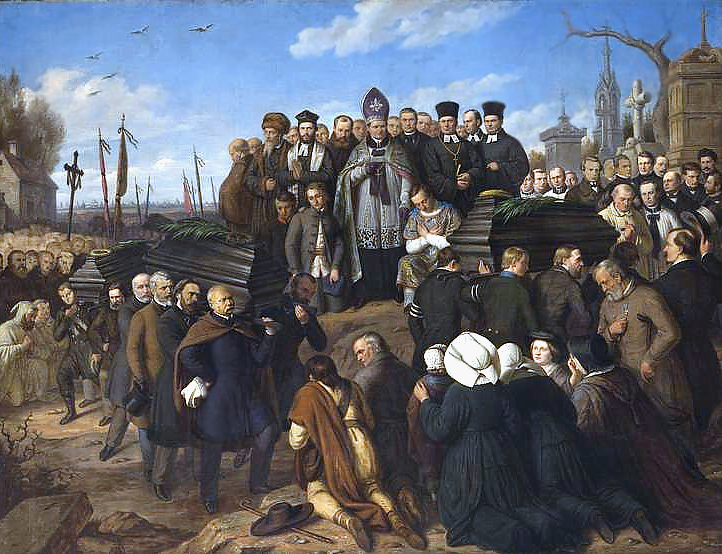The Jewish population also joined the struggle for Poland’s independence. One of the examples was the series of patriotic demonstrations in 1861 Warsaw. Some Jews stood shoulder to shoulder with Poles when the tsarist Russian authorities opened fire.
Poland ceased to exist formally in 1795 due to the joint initiative of neighboring powers: Prussia, Russia and Austria. Nevertheless, Poland continued to exist in the hearts and minds of Poles and Jews.
The period of occupation lasted 123 years (until 1918). In the face of the loss of freedom, Poles did not remain passive and denounced the obedience to the occupying forces.
History describes many examples of joint Polish-Jewish struggle, including patriotic demonstrations in the 1860s in Warsaw. They were a prelude to the armed uprising of Poles against the Russian invader – the January Uprising.
Catholics and Jews acted jointly against Russia
The Polish patriotic demonstrations organized from 1860 became a thorn in the eye of Russian authorities. With time, the Russians responded more brutally – shooting and killing the demonstrators.
Although it was winter in Warsaw, the days were hot. On February 25, 1861, a huge patriotic demonstration took place in Warsaw to commemorate the battle of Olszynka Grochowska – the bloodiest one during the entire November Uprising (February 25, 1831). Seeing the crowd that had gathered to celebrate those days, the Russians charged the crowd and beat the protesters with their sabers. One of the officers tried to snatch the banner from a Polish student, but he responded with a blow to the face. Many people were detained and sent to the Citadel – a fortress where the Russian authorities held political prisoners.
Demonstrations continued two days later, till February 27, when the Russians decided to use firearms against a defenseless crowd for the first time. A volley was fired from the Russian rifles and 5 Poles were killed among the demonstrators.
Their funeral – named “the funeral of the five fallen” – took place on March 2 and turned into another patriotic demonstration. It was attended not only by Catholics, but also by Evangelicals and Jews. They called for reconciliation between Christians and followers of Judaism and agitated to turn against a common enemy: the Russian Empire.
They shot a Jew who was carrying a cross
Another patriotic act with the participation of the inhabitants of Warsaw took place on April 8. Although the tsarist authorities banned the demonstration, the inhabitants of Warsaw took to the streets this time to bury Ksawery Stobnicki – previously persecuted by the Russian regime and sent to a katorga, which is when prisoners were sent into deep scarcely inhabited parts of Siberia to perform forced labor. The funeral once again turned into a patriotic demonstration.
The participants moved from the Catholic to the Jewish cemetery. At the grave of Antoni Eisenbaum, the director of the Warsaw Rabbinical School, who died in 1852, Poles and Jews fraternized symbolically. Rabbi Izaak Kramsztyk spoke, encouraging the cooperation of both nations. Agaton Giller, a publicist and patriotic activist, wrote that the followers of Judaism sang the Polish patriotic song “God save Poland”. The gathered people left the Jewish cemetery and began their march towards the city center. The drama was to take place there.
The crowd was led by Karol Nowakowski, a student released from the tsarist prison. He carried a cross in his hands. The Russian order was heard: get him alive! Meanwhile, Cossacks in the service of the Russians charged the crowd and beat the demonstrators. When Nowakowski could no longer carry the cross, a 17-year-old Jew, Michał Landy, picked it up but soon he fell from a Russian bullet. Several hundred people died that day including other Jews. Being watched by policemen, Michał Lande’s father, Henryk, buried his son on April 10.
They desecrated churches, imprisoned rabbis
Poles under the Russian occupation were still organizing patriotic celebrations. A large Polish demonstration with Jews took place on October 10. The occasion was the funeral of Bishop Antoni Fijałkowski. The tsarist authority responded by introducing martial law. However, it had no effect.
On October 15, Poles celebrated the 44th anniversary of the death of Tadeusz Kościuszko, who led the Polish uprising against Tsarist Russia in 1794 and fought for the independence of the United States.
They prayed in churches for the Polish-American hero when Russian soldiers broke into, beat the crowd and took them from the temples to prison. The clergy of the Catholic Church considered the churches desecrated.
Upon hearing about this, the Jewish clergy decided to show a gesture of solidarity. Dow Ber Meisels, the chief rabbi of Warsaw, ordered all synagogues in Warsaw to be closed. The Russians took revenge on the Jews and arrested Meisels and two other rabbis.
The atmosphere in Warsaw and in other parts of Poland occupied by the Russians became more and more tense. The memory of the murdered, many wounded, imprisoned and tortured in the Citadel people was alive. Soon, another climax happened- armed uprising of Poles, the January Uprising again joined Jews with Poles in the struggle against the Russian Empire.





